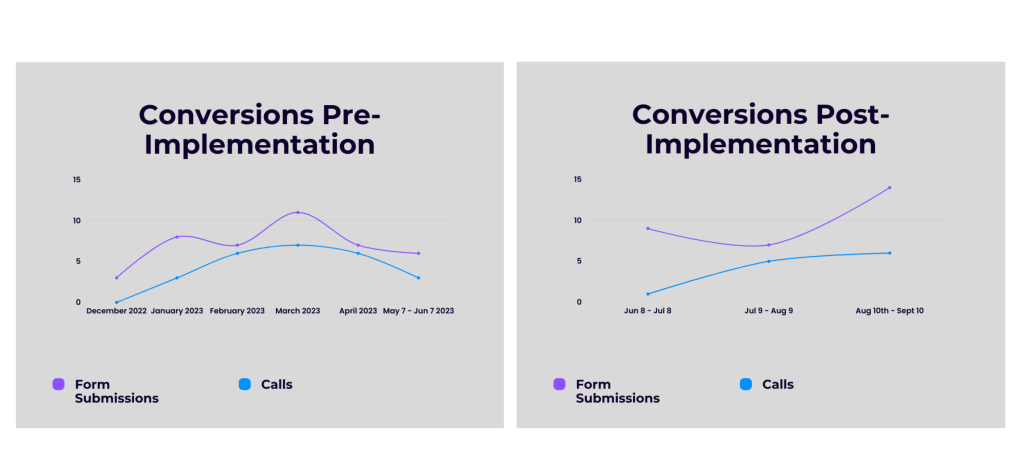Not all local SEO strategies are created equal.
But how do you know which strategy will work best for your business or the SEO client you manage?
Take your best guess? Follow “best practices”? Do whatever the latest SEO trade publication says?
Maybe.
But what if instead of guessing at what might work best for a distinct local business with a unique website in a specific locale, you had data to inform the changes you recommend?
Much better.
Local SEO testing allows you to evaluate what strategies best work at the local level. By testing, rather than applying changes wholesale, you can measure what works and to what extent it works.
In this article, we’ll share what local SEO testing entails and share some real-world examples, including how we helped one local SEO client achieve a 122% increase in conversions.
What Is SEO Testing?
SEO testing is the process of analyzing and measuring the impact of changes made to a website. Often, SEO testing involves changing one distinct element or several elements that can be grouped into a distinct category of update.
For example, if a business has numerous local landing pages, you might try testing an update to the title tags with a specific change for a subset of those local landing pages.
Or perhaps you want to update on-page content with more localization. The updates you make to a group of pages will be a bit more subjective than a specific update to the title tag but would all still fall under the category of “content localization.”
Whatever you choose to test, a proper SEO test will involve the following:
- Choosing elements to test (so you don’t change too much at once)
- Formulating a hypothesis (so you know what you’re looking for)
- (If you’re A/B or group testing) Dividing pages into control and variant groups (so you know the impact of your changes against unchanged pages)
- Implementing changes and waiting (so you allow the changes time to take effect)
- Measuring and analyzing results (so you have data on how the performance of your changes)
Want to learn more about each of these steps? Check out our guide to SEO A/B testing.
A note on SEO testing and the local business
SEO testing isn’t just for enterprise websites with hundreds and thousands of pages and tens of thousands of visitors.
Sure, the more data you have to work, the better. But smaller websites and local businesses can still achieve meaningful results and improvements through strategic testing.
Types of SEO Testing
SEO testing can generally be carried out in two ways: time-based tests or A/B (split) tests.
Time-based tests
Time-based tests can be used for any site, regardless of traffic volume. You can even test a single URL or a group of URLs.
- Identify the Change: Determine what you want to test, like moving the location in the title tag to the beginning.
- Set the Duration: Collect data for 2–4 weeks before and after the changes. In most cases, you can just use data from Google Search Console.
- Compare the Metrics: Analyze metrics like traffic, CTR, and conversions to assess the impact.
Time-based tests are valuable for their simplicity and lower barrier to entry, especially for smaller sites that might not meet the traffic thresholds required for A/B testing (more below).
A/B (or split) tests
A/B testing, also known as split testing, involves comparing two groups of URLs: the control group (unchanged) and the variant group (changed). This method of SEO testing is considered more accurate than time-based testing because it can account for seasonality and algorithm updates.
- Form Groups: Select a large set of URLs with similar content and performance, then split them into control and variant groups. Testing groups would ideally have at least 30,000 organic sessions per month.
- Make Changes: Apply the desired changes only to the variant group.
- Measure Results: We recommend using tools like SEOTesting.com to compare performance metrics between the two groups. Tools can help you calculate daily differences in metrics such as clicks and plot them to visualize the impact.
A/B tests are ideal for larger sites with significant traffic, as they require a substantial amount of data to reach statistical significance. Still, you shouldn’t be wary of A/B testing on smaller sites. You may not have large enough datasets to achieve statistically significant results, but your tests may uncover SEO opportunities that lead to more clicks and conversions—which is what local SEO testing is all about anyway.
What Can You Test in Local SEO?
Local SEO offers numerous testing opportunities. By systematically testing different elements, you can discover what works best for your audience and make data-driven decisions to improve your online presence.
Here are some common options:
Metadata testing
Testing metadata variations can help you determine which formats improve your search rankings and attract more clicks. For example, you might try moving location keywords or adding a more explicit CTA to your title tags, meta descriptions, or both. Sometimes small tweaks can lead to marked improvements in visibility and user engagement.
Internal link testing
Testing different internal linking strategies can reveal the most effective ways to enhance your site’s crawlability and ranking potential for important pages. For example, adding links on local landing pages to nearby locations may be worth testing.
UX Improvements
While sometimes considered more CRO than SEO, testing various UX elements can help you identify improvements that make your site more user-friendly and improve rankings. For example, reducing the size of hero images and ensuring key information is visible above the fold can significantly improve engagement. (More on this below!)
Content Localization
Localized content is crucial to ranking for the right local queries and engaging the right audience. Testing different approaches to content localization can help you determine what resonates most with your target market. For example, including community-specific references on location or local landing pages may be worth testing.
Local SEO Testing Case Studies
We’ve seen excellent gains for clients with time-based local SEO testing. To date, we’ve focused on what you might call SXO (search experience optimization)—a “blend” of SEO, UX, and CRO—to increase conversions. After all, if you have great traffic but no conversions, what’s the point?
We encourage you to run with your own tests that make sense for your website. Feel free to drop us a line on what you’re testing, and we’ll be sure to share updates about our latest local SEO testing experiences.
122% increase in conversions for a home builder
Increasing organic traffic is great, but what if those organic users aren’t converting?
Using Microsoft Clarity, we implemented a set of UX improvements that also positively impacted page load speed:
- Decreased the hero image size across the site
- Removed hero image on blog posts
- Added strategic CTAs based on scroll-depth and heat mapping data
- Moved contact forms on blog posts
- Strategically placed contact buttons on the homepage
While monitoring those pages for 3 months, we saw a 122% increase in phone calls and form fill-outs. With this data, we’re now working on even more UX and site speed improvements and expect a continued rise in conversions.

35% increase in phone calls for a home services company
Using Clarity again, we determined that a home services client’s contact page was not quite satisfying users. Heat maps and screen recordings showed that users were looking to call, but the page’s layout was limiting access to the most relevant phone numbers. After presenting the right phone numbers clearly and obviously above the fold, we observed a 35% increase in clicks to call.
Local SEO Testing for More Conversions
Following local SEO “best practices” can sometimes take a business’s website pretty far. Still, with SEO “democratized” and every competitor “doing SEO,” we need to strive to find ways to stand out and make our digital products the best they can be.
Local SEO testing helps us uncover what works in highly specific situations. The findings and data may very well apply across other websites, but the point is to test what works for your website to drive real-world improvements and, ultimately, business success.
When you need more impressions, clicks, and conversions, why not try testing something new?
Ready to run some local tests?
Schedule a discovery call with RicketyRoo
and discover opportunities today.



